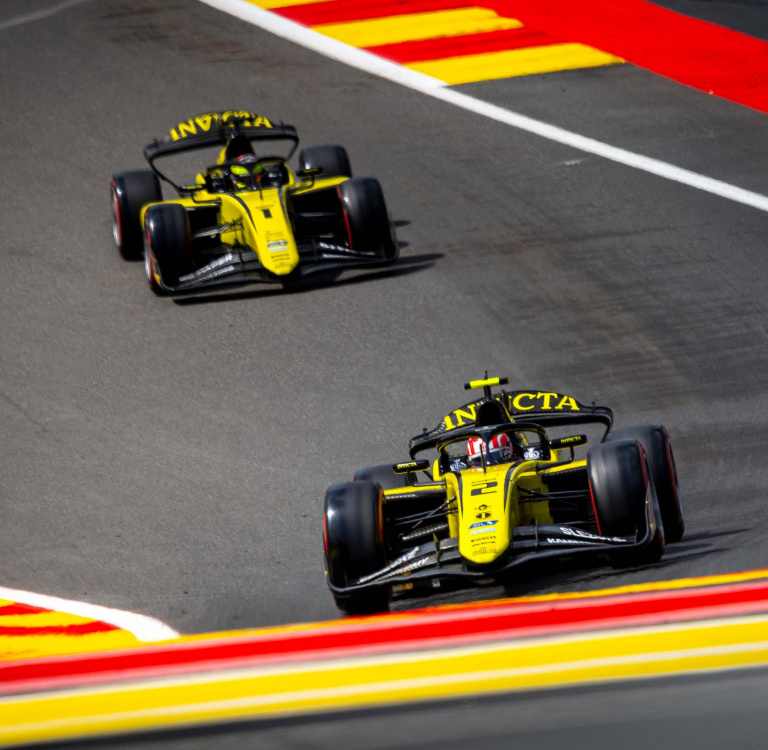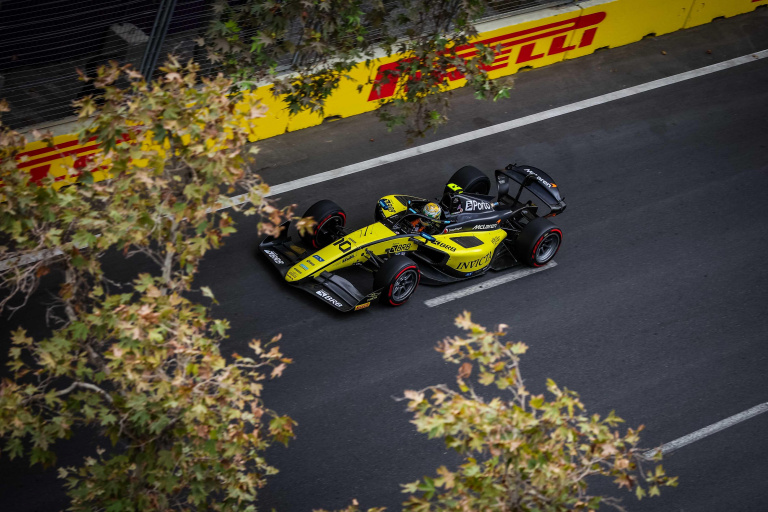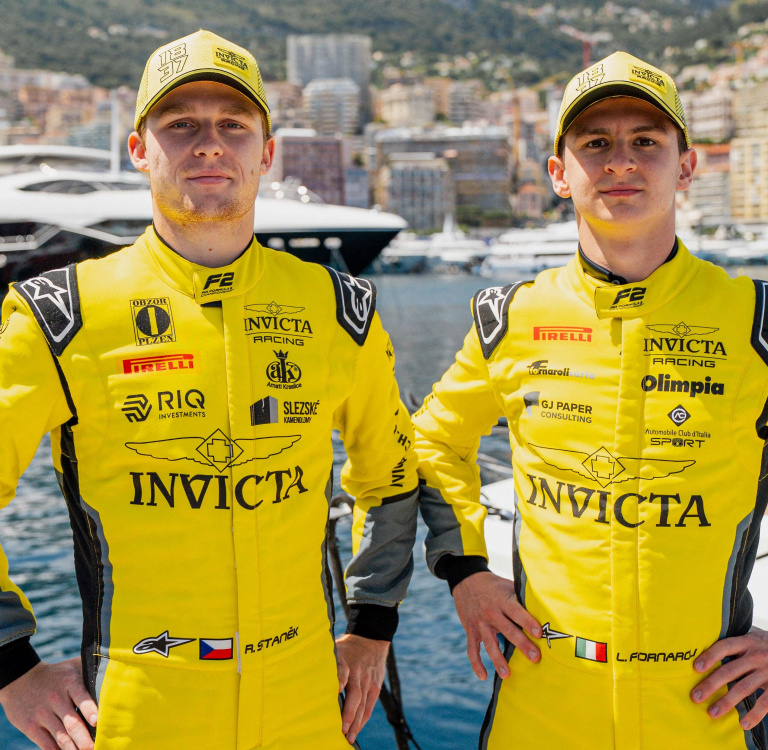Gabriel Bortoleto will drive for Kick Sauber in Formula 1 next season, becoming the latest in a long line of Brazilian Grand Prix drivers stretching all the way back to 1951.
As the third-most decorated country when it comes to F1 titles (8), Brazil boasts a rich heritage in the sport and a fanbase as passionate as Italy’s Tifosi or Verstappen’s orange army.
It’s been a long time since the Brazilian national anthem rang out over an F1 podium though, with the last win coming 15 years ago. Longer still Brazilian F1 fans have waited for another champion to come along. That’s been over 30 years now.
Invicta Racing’s own Brazilian FIA Formula 2 prodigy has a lot to live up to then. He’s donned a helmet paying tribute to his racing idol Ayrton Senna this season to the delight of many fans, but next year his own F1 journey begins, and he must forge his own path if he is to be mentioned in the same breath as the other Brazil-born greats.
Here, we look back at the country’s history in F1 and the great drivers Bortoleto hopes to emulate.
Chico Landi: The first of many
Chico Landi’s pedigree predates the F1 championship’s inception in 1950, having been one of several drivers responsible for popularising Brazilian motorsport in the thirties. He won several Grand Prix in the forties and was considered the best racer Brazil had to offer before the war.
Racing in F1’s second-ever season, Landi became the first of Brazil’s 32 Grand Prix drivers to date and he competed in a handful of one-off races over the next three seasons. Returning for another one-off event at the 1956 Argentine Grand Prix, he secured his best F1 finish of fourth with Maserati.
Emerson Fittipaldi: A meteoric rise
Brazil’s first F1 driver since Fritz d’Orey in 1959, Emerson Fittipaldi or ‘Emmo’ joined the grid in 1970, but his initiation into the sport was an ordeal few could fathom.
Having won the Brazilian karting and Formula Vee championships in entries of his own making, the mild-mannered Emmo moved to the UK in 1969 and quickly won the British Formula Three championship, attracting the attention of Lotus head honcho Colin Chapman. After impressing in Formula Two with Lotus in the 1970 season, Fittipaldi was fielded in a third Lotus F1 car from the British Grand Prix of that year.
Just three races into the young Brazilian’s F1 career, the unthinkable happened when Lotus team-mate Jochen Rindt was tragically killed in a crash at Monza. When a distraught John Miles – the other Lotus driver – walked away from the sport altogether, Fittipaldi was left to spearhead the team. Remarkably, he went on to win the very next race, ensuring Rindt would posthumously win the title.
Persisting injuries from a road accident would leave Fittipaldi winless in ’71, but ’72 would be his finest hour, piloting the supremely fast Lotus 72 to five wins and a maiden title at just 25 years old. That made him the youngest F1 champion in history at that point.
Following a season as runner-up and an intra-team rivalry with Ronnie Peterson in 1973, Emmo joined McLaren for 1974 and, at the wheel of the M23, took three more victories and a second F1 drivers’ title.
Although his F1 career fizzled out when the family-backed Copersucar venture didn’t pan out as intended, Fittipaldi went on to race in IndyCar precursor CART, becoming champion in 1989 and winning the Indy 500 twice.
Nelson Piquet: Quite the character
On the complete opposite end of the spectrum to Fittipaldi, the opinionated playboy Nelson Piquet joined the grid during the twilight of his far quieter countryman’s career, having been inspired by his success.
Despite fierce resistance from his parents – his father being a government minister in Brazil – and several attempts to steer young Nelson in the direction of academia and tennis, he wouldn’t be convinced otherwise. Racing was in his blood.
Finally, in 1977, he sold his road car to fund his Formula Vee exploits. The gamble paid off, with Nelson taking Brazilian titles before jumping into British Formula Three, a championship he also won in 1978 at a canter from Derek Warwick. More than enough to secure a spot in F1.
After a year under the tutelage of Niki Lauda at Brabham, Nelson faced the daunting prospect of leading the team in just his second season, just as Fittipaldi had 10 years prior. It seemed he was more than up to the challenge though, taking three wins in 1980 to finish second behind Alan Jones. In ’81, he’d go one better, clinching his first title by one point after another three victories.
With an unreliable BMW turbo engine bolted into the Brabham for 1982, Nelson took just one victory, but in ’83 he and the team were back to their best. He secured another three wins en route a second drivers’ title, this time by just two points after an enduring battle with Alain Prost.
The Brazilian was becoming known for a lavish and controversial lifestyle, and after two underwhelming seasons, he tried to negotiate a doubling of his retainer. When Bernie Ecclestone and Brabham refused, he was lured away to Williams by an even bigger paycheck.
The feud between Piquet and Williams team-mate Nigel Mansell is well documented, and in 1986 it got the better of them when Prost and McLaren snatched the title from under their noses. In ’87 though, Nelson was relentlessly consistent, taking half of Mansell’s six-win tally but eight further podiums were enough to secure his third title.
Results declined in his final four seasons of F1, with a best finish of third in the 1990 standings behind the all-conquering McLarens. Like Fittipaldi, Piquet dabbled in other series, but injuries sustained while qualifying for the 1992 Indy 500 put pay to any serious efforts.
Ayrton Senna: A legend among legends
Arguably the most iconic F1 driver to ever live, Ayrton Senna first drove a miniature go kart at the age of 4 and by 13, he was racing competitively. With back-to-back runner-up finishes in the world karting championship in 1979 and 1980, Senna, like his compatriots before him, moved across the world to race single-seaters in the UK.
Over the next three seasons, Ayrton collected five titles in various Formula Ford championships across Europe. Results like that don’t go unnoticed, and in 1984 he made his F1 debut with Toleman where he scored three podiums, including that fabled Monaco drive to second in treacherous conditions.
In a bold move, Senna paid off his Toleman contract – deeming their resources to be insufficient for his aspirations – and moved to Lotus for ’85. Another three seasons of driving beyond his machinery followed, notching a remarkable 16 poles and six wins. In his last year with Lotus, he finished third in the standings behind Piquet and Mansell in the dominant Williams.
Again, Ayrton was hungry for more and made the switch to McLaren, partnering Prost in what became the sport’s defining intra-team rivalry. In the next four seasons, he was the ultimate force in F1, claiming three titles in 1988, 1990 and 1991.
The first year of the pairing was utter domination, as they secured 15 of the 16 race victories and Senna claimed the title.
The following year brought with it more friction between the team-mates, culminating in the infamous crash at the Suzuka chicane. Although Senna went on to win that race, he received a controversial penalty for using the escape road that ultimately denied him a shot at the title.
Ayrton would have his vengeance the following year, securing his second championship by way of another collision with Alain at Suzuka, this time at the first corner.
Leaving no room for debate in 1991, Senna obliterated the competition to comfortably wrap up a third title as his prowess grew ever stronger.
The 1992 and 1993 seasons would once again see Senna perform a magnitude above what the car was capable of, as he hustled a now underperforming McLaren to eight victories and the runner-up spot behind old rival Prost in his final year with the team.
His dazzling F1 career came to a devastating end on that fateful day at Imola in 1994, but memories of his mesmerising brilliance on a qualifying lap, clinical racecraft and exceedingly kind spirit away from the track endure, permeating every corner of the sport he loved so much.
Rubens Barrichello and Felipe Massa: the most recent race winners
There have been more recent Brazilian F1 drivers – Pietro Fittipaldi’s one-off Miami appearance in 2020 and Felipe Nasr as the country’s last full-time driver in 2016 – but Rubens Barrichello and Felipe Massa are the last to have tasted victory.
Rubens is perhaps best known for his stint at Ferrari partnering Michael Schumacher from 2000 to 2005, but the young Brazilian put in some stellar performances at Jordan and Stewart – taking six podiums and pole position at the 1999 French Grand Prix – in his early career.
While at Ferrari, Barrichello would finish runner-up in the drivers’ championship twice (2002 and 2004) and notch nine Grand Prix victories. After two challenging seasons with Honda, of which the highlight was third at the 2008 British Grand Prix, he fought team-mate Jenson Button and Sebastian Vettel for the 2009 title, taking another two wins with Brawn GP.
Like Barrichello, Felipe Massa is best known for his stint with the Scuderia following three years of consistent point-scoring with Sauber. In 2006, he crossed paths with Schumacher, whose tenure at Ferrari was coming to an end while Felipe’s was only just getting started. With wisdom from the seven-time champion imparted, the young Brazilian came on strong in the latter half of the year to take two wins, playing a key role in his team-mate’s pursuit of eventual champion Fernando Alonso.
He'd finish a distant fourth in the epic three-way 2007 title fight, but 2008 would be his finest, and most crushing season. Taking six wins to Lewis Hamilton’s five, Massa was on course to take a famous home win at Interlagos – and the title along with it – until the Brit passed Timo Glock on the final corner of the final lap, denying Brazil the crowning of their champion by a solitary point.
At the Hungarian Grand Prix in 2009, a loose spring stuck Felipe’s head and the resulting injuries left him recovering for the second half of the season. Although he made an impressive recovery to take seven more podiums for Ferrari (five in 2010 and two in 2012), he couldn’t reach the title-contending heights he once had.
Both Barrichello and Massa brought Brazil back to the top step in the modern era, and both came close to achieving the ultimate goal of championship glory, but ultimately their efforts fell just short. That’s left Brazil without an F1 champion for the longest streak since Fittipaldi first claimed the crown.
Now, the question on every Brazilian F1 fan’s lips is ‘can Gabriel Bortoleto put an end to that run?’ Should he win the F2 title, he’d follow in the footsteps of Charles Leclerc, George Russell and Oscar Piastri, all of whom have won titles in their rookie seasons of F3 and F2, all of whom are Grand Prix winners and touted as champions in the making. Gabriel not only has that reputation to uphold in 2025, but the weight of Brazil on his shoulders too. We think he’s up to the challenge.


